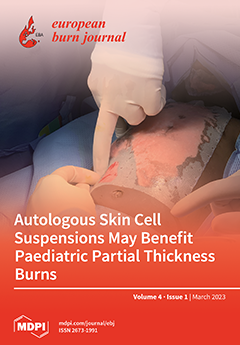Background: There is little evidence regarding the efficacy of Regenerative Epidermal Suspension (RES™) management for paediatric partial-thickness burns. The Biobrane
® RECELL
® Autologous skin Cell suspension and Silver dressings (BRACS) Trial evaluated three dressings for the re-epithelialisation of partial-thickness burns in children.
[...] Read more.
Background: There is little evidence regarding the efficacy of Regenerative Epidermal Suspension (RES™) management for paediatric partial-thickness burns. The Biobrane
® RECELL
® Autologous skin Cell suspension and Silver dressings (BRACS) Trial evaluated three dressings for the re-epithelialisation of partial-thickness burns in children. Methods: Eligible children (age ≤ 16 years; ≥5% TBSA; ≤48 h of injury) were randomised to silver dressings, RES™/Biobrane
® or Biobrane
®. The measured outcomes were the time to re-epithelialisation (primary outcome), pain, itch, intervention fidelity, treatment satisfaction, health-related quality of life, health resource utilisation and adverse effects. Results: The median time to re-epithelialisation in days was no different for RES™/Biobrane
® at 12 (IQR: 5.6–18.4;
n = 7) and slower by two days for Biobrane
® at 14 (IQR: 6.3–21.7;
n = 7) when compared to silver dressings 12 (IQR: 3.7–20.3;
n = 8). Reduced pain, fewer infections, no sepsis, no skin graft, and the lowest impact on health-related quality of life were reported in the RES™/Biobrane
® group compared to other groups. Due to the COVID-19 pandemic, recruitment suspension resulted in a smaller cohort than expected and an underpowered study. Conclusions: The pilot trial findings should be interpreted cautiously; however, they indicate that a fully powered randomised controlled trial is warranted to substantiate the role of RES™ for medium to large paediatric partial-thickness burn management.
Full article




